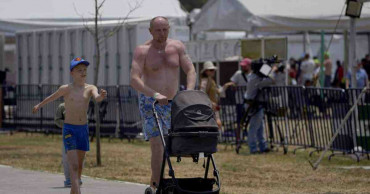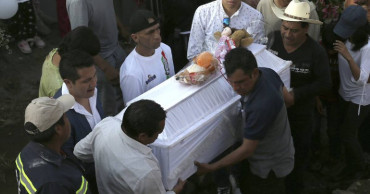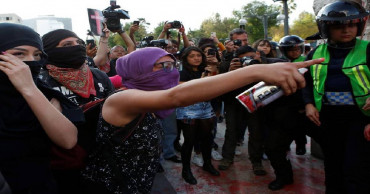Mexico City
Bangladesh Embassy in Mexico observes historic March 7
With due respect and fervor, the Embassy of Bangladesh in Mexico City observed the historic March 7. The day commenced by hoisting of the national flag by Ambassador Abida Islam to the tune of the national anthem and placing a wreath at the bust of Bangabandhu Sheikh Mujibur Rahman in presence of the members of the Bangladesh community as well as all the embassy officials.
It was followed by reading out the messages of the President and Prime Minister given on this occasion.
The historic March 7 speech of Bangabandhu was read out by the local staff members of the embassy, both in English and Spanish languages.
A special documentary titled ‘The Historic 7th March speech of Bangabandhu Sheikh Mujibur Rahman’ and a short film based on the Liberation War of Bangladesh, ‘Omar Faruker Ma’ directed by Zahidur Rahman Biplob, were screened at the event.
Also read: Historic March 7 observed at Bangladesh Embassy in Washington DC Ambassador Abida Islam in her speech paid rich tributes to the Father of the Nation Bangabandhu Sheikh Mujibur Rahman as well as to all the valiant freedom fighters.
In her speech, she elaborated the significance of the March 7 speech and its contribution in the war for independence in 1971.
2 years ago
On eve of Biden's border visit, migrants fear new rules
Several hundred people marched through the streets of El Paso Saturday afternoon, and when they arrived at a group of migrants huddling outside a church, they sang to them “no estan solos” — “you are not alone.”
Around 300 migrants have taken refuge on sidewalks outside Sacred Heart Church, some of them afraid to seek more formal shelters, advocates say, amid new restrictions meant to crack down on illegal border crossings.
This is the scene that will greet President Joe Biden on his first, politically thorny visit to the southern border Sunday.
The president announced last week that Cubans, Nicaraguans, Haitians and Venezuelans will be expelled to Mexico if they enter the U.S. illegally — an expansion of a pandemic-era immigration policy called Title 42. The new rules will also include offering humanitarian parole for up to 30,000 people a month from those four countries if they apply online and find a financial sponsor.
Biden is scheduled to arrive in El Paso Sunday afternoon before traveling on to Mexico City to meet with North American leaders on Monday and Tuesday.
Read more: Biden agenda, lithium mine, tribes, greens collide in Nevada
Dylan Corbett, who runs the nonprofit Hope Border Institute, said the city is experiencing an increasing “climate of fear.”
He said immigration enforcement agencies have already started ratcheting up deportations to Mexico, and he senses a rising level of tension and confusion.
The president’s new policy expands on an existing effort to stop Venezuelans attempting to enter the U.S., which began in October.
Corbett said many Venezuelans have since been left in limbo, putting a strain on local resources. He said expanding those policies to other migrants will only worsen the circumstances for them on the ground.
“It’s a very difficult situation because they can’t go forward and they can’t go back,” he said. People who aren’t processed can’t leave El Paso because of U.S. law enforcement checkpoints; most have traveled thousands of miles from their homelands and refuse to give up and turn around.
“There will be people in need of protection who will be left behind,” Corbett said.
The new restrictions represent a major change to immigration rules that will stand even if the U.S. Supreme Court ends a Trump-era public health law that allows U.S. authorities to turn away asylum-seekers.
El Paso has swiftly become the busiest of the Border Patrol’s nine sectors along the U.S. border with Mexico, occupying the top slots in October and November. Large numbers of Venezuelans began showing up in September, drawn to the relative ease of crossing, robust shelter networks and bus service on both sides of the border, and a major airport to destinations across the United States.
Venezuelans ceased to be a major presence almost overnight after Mexico, under Title 42 authority, agreed on Oct. 12 to accept those who crossed the border illegally into the United States. Nicaraguans have since filled that void. Title 42 restrictions have been applied 2.5 million times to deny migrants a right to seek asylum under U.S. and international law on grounds of preventing the spread of COVID-19.
Read more: Biden intends to make his first visit to US-Mexico border
U.S. authorities stopped migrants 53,247 times in November in the El Paso sector, which stretches across 264 miles of desert in West Texas and New Mexico but sees much of its activity in the city of El Paso and suburban Sunland Park, New Mexico. The most recent monthly tally for the sector was more than triple the same period of 2021, with Nicaraguans the top nationality by far, followed by Mexicans, Ecuadoreans, Guatemalans and Cubans.
Many gathered under blankets outside Sacred Heart Church. The church opens its doors at night to families and women, so not all of the hundreds caught in this limbo must sleep outside in the dropping temperatures. Two buses were available for people to warm up and charge their phones. Volunteers come with food and other supplies.
Juan Tovar held a Bible in his hands, his 7-year-old daughter hoisted onto his shoulders. The 32-year-old was a bus driver in Venezuela before he fled with his wife and two daughters because of the political and financial chaos that has consumed their home country.
He has friends in San Antonio prepared to take them in, he said. He’s here to work and provide an education for his daughters, but he’s stuck in El Paso without a permit.
“Everything is in the hands of God,” he said. “We are all humans and we want to stay.”
Another Venezuelan, 22-year-old Jeremy Mejia, overheard and said he had a message he’d like to send to the president.
“President Biden, I ask God to touch your heart so we can stay in this country,” Mejia said. “I ask you to please touch your heart and help us migrants have a better future in the U.S.”
2 years ago
Ukrainian refugees at camp in Mexico City await US action
On a dusty field on the east side of Mexico’s sprawling capital, some 500 Ukrainian refugees are waiting in large tents under a searing sun for the United States government to tell them they can come.
The camp has only been open a week and 50 to 100 people are arriving every day. Some have already been to the U.S. border in Tijuana where they were told they would no longer be admitted. Others arrived at airports in Mexico City or Cancun, anywhere they could find a ticket from Europe.
“We are asking the U.S. government to process faster,” said Anastasiya Polo, co-founder of United with Ukraine, a nongovernmental organization, that collaborated with the Mexican government to establish the camp. She said that after a week’s time none of the refugees there “are even close to the end of the program.”
The program, Uniting for Ukraine, was announced by the U.S. government April 21. Four days later, Ukrainians showing up at the U.S.-Mexico border were no longer exempted from a pandemic-related rule that has been used to quickly expel migrants without an opportunity to seek asylum for the past two years.
Instead, they would have to apply from Europe or other countries such as Mexico. To qualify people must have been in Ukraine as of Feb. 11; have a sponsor, which could be family or an organization; meet vaccination and other public health requirements; and pass background checks.
Also Read: Civilians rescued from Mariupol steel plant head for safety
Polo said U.S. government officials had told her it should take a week to process people, but it appeared like it was just beginning. Some of the first arrivals had received emails from the
U.S. government acknowledging they received their documents and the documents of their sponsors, but she had heard of no sponsors being approved yet.
“These people cannot stay in this camp, because it is temporary,” Polo said. More than 100 of the camp’s residents are children.
Nearly 5.5 million Ukrainians, mostly women and children, have fled Ukraine since Russia invaded its smaller neighbor on Feb. 24, according to the U.N. High Commissioner for Refugees.
Giorgi Mikaberidze, 19, is among the waiting. He arrived in Tijuana April 25 and found the U.S. border closed. He complained that the U.S. government had given so little notice, because many people like himself were already in transit. He went from being just yards from the United States to some 600 miles (966 kilometers) now.
When the U.S. government announced in late March that it would accept up to 100,000 Ukrainian refugees, hundreds entered Mexico daily as tourists in Mexico City or Cancun and flew to Tijuana to wait for a few days – eventually only a few hours – to be admitted to the U.S. at a San Diego border crossing on humanitarian parole. Appointments at U.S. consulates in Europe were scarce, and refugee resettlement takes time, making Mexico the best option.
Traveling through Mexico was circuitous, but a loose-knit group of volunteers, largely from Slavic churches in the western United States, greeted refugees at the Tijuana airport and shuttled them to a recreation center that the city of Tijuana made available for several thousand to wait. A wait of two to four days was eventually shortened to a few hours as U.S. border inspectors whisked Ukrainians in.
That special treatment ended the day Mikaberidze arrived in Tijuana.
“We want to go to America because (we’re) already here, some don’t have even money to go back,” he said.
Mikaberidze was visiting relatives in Georgia, south of Ukraine, when the Russian invasion occurred and was not able to return. His mother remains in their village near Kharkhov in eastern Ukraine, afraid to leave her home because Russian troops indiscriminately shoot up cars traveling in the area, he said.
“She said it’s a very dangerous situation,” said Mikaberidze, who traveled to Mexico alone.
Also Read: Evacuation of civilians from Ukrainian steel plant begins
The Mexico City camp provides a safe place to wait. It was erected inside a large sports complex, so Ukrainians could be seen pushing strollers with children along sidewalks, playing soccer and volleyball, even swimming.
However, the refugees have been warned that while they are free to leave the complex, no one is responsible for their safety. Iztapalapa, the capital’s most populated borough, is also one of its most dangerous.
The Mexican government was providing security at the camp with about 50 officers, Polo said. The Navy had also set up a mobile kitchen to provide meals.
She said they felt safe inside the camp, but were asking the government about the possibility of moving the camp to a safer area.
Mykhailo Pasternak and his girlfriend Maziana Hzyhozyshyn, waited at the entrance to the complex Monday afternoon. Both suffering from an apparent head cold, they planned to move to a hotel for a day or two to try to get some sleep and recover before returning to the camp.
Pasternak had left the U.S. to help Hzyhozyshyn get in. The two had spent several days in Tijuana before flying to Mexico City and arriving at the camp Sunday.
The couple stood out on the streets of Iztapalapa and appeared to be withering under the relentless sun. The couple had known each other for six years.
“She’s my love,” Pasternak said.
3 years ago
Wealthier nations should provide more trade access to poorer countries: Shahriar
Bangladesh State Minister for Foreign Affairs Md Shahriar Alam has called on wealthier nations to provide more trade access to poorer countries so as to stimulate their economic growth.
He also highlighted the steps taken by the Bangladesh government to ensure full compliance with international labour laws, particularly in the readymade garment industry, during his meeting with Mexican Deputy Minister for Foreign Trade Luz Maria de la Mora Sanchez in Mexico City Tuesday.
The two Ministers, in fact, discussed ways to bolster bilateral trade and investment ties at the meeting.
Read:Shahriar joins Mexican independence anniversary celebration
Shahriar told the Mexican Minister that "setting bilateral trade targets may be aspirational but useful". He has already set a target of US one billion dollars during an interaction with the business community of the two countries.
On her part, the Mexican Minister underscored the importance of moving forward, "as both countries have many people who are left behind".
4 years ago
At least 1 dead, 10 missing in landslide near Mexico City
A section of mountain on the outskirts of Mexico City gave way Friday, plunging rocks the size of small homes onto a densely populated neighborhood and leaving at least one person dead and 10 others missing.
Firefighters scaled a three-story pile of rocks that appeared to be resting on houses in Tlalnepantla, which is part of Mexico state. The state surrounds the capital on three sides.
As rescuers climbed the immense pile of debris, they occasionally raised their fists in the air, the familiar signal for silence to listen for people trapped below. Firefighters and volunteers formed bucket brigades to pass 5-gallon containers of smaller debris away as they excavated.
“In this moment our priority is focused on rescuing the people who unfortunately were surprised at the site of the incident,” said Tlalnepantla Mayor Raciel Pérez Cruz in a video message. Authorities had evacuated surrounding homes and asked people to avoid the area so rescuers could work.
Rescuers carried a body on a stretcher covered with a sheet past AP journalists. The Mexico state Civil Defense agency said in a statement that at least 10 people were reported missing.
Among the volunteers were 30-year-old construction worker Martin Carmona, 30, and his 14-year-old son. “They organized us in a chain to take out buckets of sand, stone and rubble,” Carmona said. “A co-worker lives there. He has a wife and two young children under the debris.”
READ: Mexico City metro overpass collapses onto road; 20 dead
Carmona and his son arrived to the pile before government rescuers and his friend was already there digging for his wife and kids.
Neighbors began to complain that they need more help and organization.
Carmona said rescuers heard children, but after two hours of removing debris, authorities told volunteers to leave the area. Only relatives stayed to help the rescuers.
Search dogs clambered over the rubble with their handlers.
Ana Luisa Borges, 39, said she lives just three houses down from those hit by the landslide.
“It thundered horribly,” she said of the sound of the slide. “I grabbed my youngest son and ran out (of the house). Then came a very big cloud of dust.” Fortunately, her other four children were in school.
“There are a number of houses there,” she said of the slide area. “There was a building, but they tell us there are people there and children. I saw one person come out with head injury.”
Borges said they have been warned that another rock could come down and that she didn’t know where they were going to sleep tonight.
“They’ve only told us that we have to leave (our homes),” she said.
Tlalnepantla officials announced they were opening several shelters for displaced residents.
The neighborhood is a heap of jumbled houses climbing the mountainside, many with corrugated tin roofs, separated in places by just a steep staircase.
One massive boulder stopped against a two-story house barely its equal, knocking out the front wall and spilling the home’s contents into the street. A path of destruction traced uphill.
Maximinio Andrade, who lives with his parents and siblings — 14 family members in all — near the slide walked down the steep street pushing a flat-screen television on a hand cart. He had not been home at the time of the landslide, but feared thieves would enter now that the surrounding homes had been evacuated.
READ: Mexico City Under Fire
“They’ve already started stealing from the destroyed homes,” he said.
National Guard troops and rescue teams carrying lengths of rope made their way through narrow streets.
Images from the area showed a segment of the steep, green side of the peak known as Chiquihuite sheared off above a field of giant rubble with closely packed homes remaining on either side.
Mexico state Gov. Alfredo del Mazo said via Twitter that local, state and federal authorities were coordinating to secure the zone in case of more slides and to remove rubble to locate possible victims.
The landslide follows days of heavy rain in central Mexico and a 7.0-magnitude earthquake Tuesday night near Acapulco that shook buildings 200 miles (320 kilometers) away in Mexico City.
While visiting the scene later Friday, Del Mazo said authorities believe four homes were destroyed in the landslide and another 80 were evacuated as a precaution.
“It’s likely the earthquake and the intense rain we have had in recent days have affected (the area) and for this came the landslide and the break up of the mountain,” he said.
4 years ago
Mexico City arrests 2 suspects in death of 7-year-old girl
Authorities said late Wednesday they arrested a woman and a man suspected in the kidnapping of a 7-year-old girl whose dead body was found wrapped in a plastic bag days later, a case that has provoked outrage in Mexico as the latest brutal example of killings of women and girls.
5 years ago
Mexican women protest murders of activists, target monuments
Several hundred feminist activists warmed up with chants Saturday next to a monument to murdered Mexican women before filling a street in the capital and dousing female police officers with red paint.
5 years ago
Mexico City Under Fire
Oct 28(AP/UNB) -- A bullet hole fragments the window of a building, from a recent shootout in Culiacan, Mexico, Saturday, Oct. 26, 2019. The physical scars of the Oct. 17 gunbattles _ what’s come to be known as “black Thursday” by residents of Culiacan, the capital of Sinaloa and a stronghold of the Sinaloa cartel long led by Joaquín “El Chapo” Guzmán _ are beginning to heal, but residents are still coming to grips with the worst cartel violence in recent memory.
6 years ago




.jpg)









